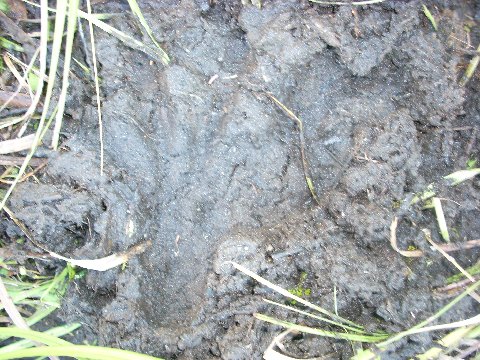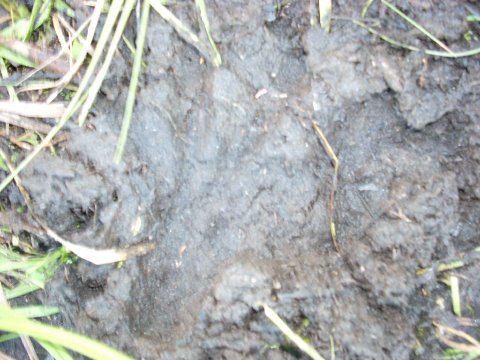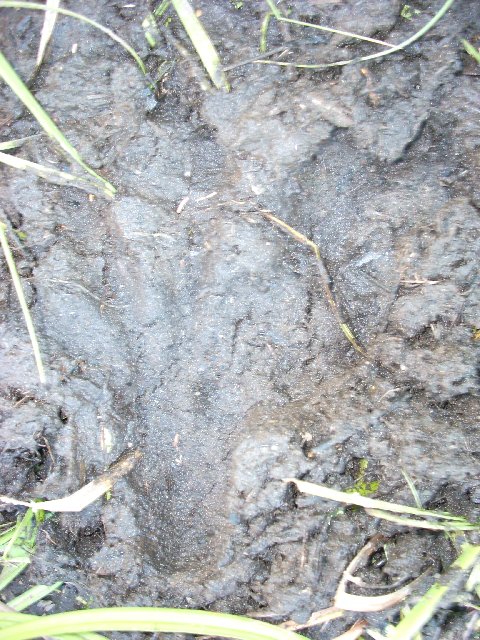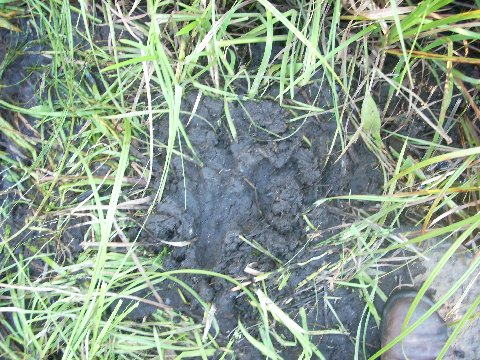Minnesota Mystery Track
Posted by: Loren Coleman on September 3rd, 2008
I receive emails, lots of messages, through my website. Some of them contain intriguing items that people are innocently trying to identify. I received one such email from a Ms. Sheila Cave of Minnesota, who with her family, had found a large, mystery footprint. I followed up with various questions about how she found this lone track.
I also asked her permission to share the following images here, to see what kinds of ideas people might have on the originals of the photographed footprint.
First some background on the find.
Ms. Cave began with a simple inquiry, through a contact page (not tied to Cryptomundo), asking if I would look at her track photos to see if I could tell her what the animal might have been:
I would like to send you some photos I had taken on a recent weekend trip up to Isabella, MN. We were deep into the wilderness along the Mitawan stream jumping rocks and logs catching trout when I stumbled across an unknown track of an animal. I didn’t have plaster with me, but I did have my camera, and based on the size of my shoe in one of the pictures, I’m estimating the track to be about 8 1/2-9 inches in length.
I asked for more details, and for her to forward the photos. Here’s what I received, which clearly, while I thought this was probably a mundane animal or a hoax, I found interesting, the more she told me about how and where she found it:
My husband, myself, and our two sons were walking along the Mitowan stream up in Isabella, MN Sunday, August 31st, 2008 doing some trout fishing. My husband decided that he wanted to go deeper into the woods to follow the stream in the hopes that he would find some good deep trout holes, so I followed him way back into the woods around several bends of the stream through some tough terrain.
We came across this area (where the tracks were found) and it looked like a good spot to catch trout, several large timbers over the water, old glacier rocks and large deep cesspools so we climbed up on some rocks and one of my son’s started fishing there. I started taking some photos of the area and wanted to get a better capture of my son fishing so I decided to jump over to the rock (where I found the prints in the mud). The prints were not visible and surrounded by grass prior to me jumping over to that rock. Had I not jumped over there, I would have never seen them or found them.
When I got over to the flat rock, I immediately saw the prints in the mud. My first impression was being mystified at the size of the track. I bent over closely to look at the long (finger-hand like look of the claws and seeing the small indentations of the tip of the claw in the mud) I was amazed at the size of the heel which reminded me of a human heel. I hollered to my husband to come over and look at the track. He’s been an avid outdoors man spending a great deal of time in the wilderness and he had never seen a track like that before he said “it was really weird”.
I took out my Nikon Coolpix 6.0 digital camera and took several photos of different angles, close ups and put my boot in one photo for a size comparison. I kept studying the print trying to figure out what it could be. I wasn’t certain how clear any of the pictures would come out until I got home to put them on my computer. I just held the camera as steady as I could. After taking the photos, I started pushing the tall grass back behind the print looking for any additional prints, but could find none. My husband had already walked through the mud along the embankment coming over to the rock where I was so if any additional prints had been there, they were already trampled.
Once home, I immediately began looking for answers to what the print was. It measured 8 1/2 inches long based on my boot print in comparison and from appearances, looked like a five toed animal, much like that of a beaver, muskrat (which is closely resembled especially the heel) and a raccoon. However, this track measured 4 inches longer than a Beaver, 6 inches longer than a muskrat and 4 1/2 inches longer than that of a raccoon which didn’t make identification easy for me. I realized quickly this was not any type of bird track, as all large birds (Eagles, Wild Turkeys, Owls, etc) have only 3 toes and not a large wide heel but a 4th skinny claw (for a heel) and the center claw (2nd toe) lines up with the heel unlike that of my track which indicates a five claw toed animal. This animals heel is very deep into the mud, at least close to two inches unlike it’s finger-like claws, so the animal put most of it’s weight on the heel when it stepped there. I wished with all of my heart that I would have had some plaster with me at that moment of finding this. I was so focused on the print that I didn’t even noticed until I came home that the photo contained a print of a moose/deer hoof track that partially stepped over the unknown track on the right side.
Bewildered, I then contacted the MN DNR, and Robert Kirsch was assigned to analyze the photos. He emailed me on September 2nd in the evening with the response “there is not a native species that leaves a track like this”.Sheila Cave

I feel this track may be of something of importance because of it’s uniqueness and size. Like I wrote in my previous note, the track is a five clawed toed track, although a portion of the track is covered on the right side by a moose or deer hoof stepping on it.
My boot in one of the photos measures 11 inches, so I estimated the track to be 8 1/2 – inches long. The heel portion was about two inches wide and over 3 inches long. The long finger/hand like claws were over 4 inches long with a spread of over 3 inches between the first claw to the middle(center claw) directly above the heel. The 4th claw was covered by a moose or deer track and the 5th is in the moose/deer track.
I realized quickly this was not any type of bird track, as all large birds (Eagles, Owls, etc) have only 3 toes and not a large wide heel but a 4th claw (for a heel) and the center claw lines up with the heel unlike that of my track which indicates a five claw toed animal.
When I ran searches for five claw toed animals, I found that the print most closely matches a beaver, muskrat (especially in the hand-claw like look and large heel), and a raccoon, however, the print [I found] is 4 inches larger than a normal beaver, 6 inches larger than the normal muskrat and 4 1/2 inches larger than the raccoon.
All photos were analyzed by Robert D. Kirsch of the MN DNR Two Harbors, MN and his [email] response was “there is not a native species that leaves a track like this”. Sheila Cave



When I call it “prints” is because the photos I took contain at least two animals, the “unknown five toed large heeled animal and the moose/deer print that goes over it in the upper right section. That’s why I’m calling it “prints”. Because there is more than one print in the photo. Sheila Cave


Prior to finding the prints, I had taken this photo from the angle where my son was fishing. (behind me)
Near the bottom center is the flat rock surrounded by grass that the prints were found on,
you can barely see the mud in this photo that is located to the upper left portion of that rock.If I had not jumped over to that rock, I would have never seen that print at all. Sheila Cave

Okay, folks, what do you think?
About Loren Coleman
Loren Coleman is one of the world’s leading cryptozoologists, some say “the” leading living cryptozoologist. Certainly, he is acknowledged as the current living American researcher and writer who has most popularized cryptozoology in the late 20th and early 21st centuries.
Starting his fieldwork and investigations in 1960, after traveling and trekking extensively in pursuit of cryptozoological mysteries, Coleman began writing to share his experiences in 1969. An honorary member of Ivan T. Sanderson’s Society for the Investigation of the Unexplained in the 1970s, Coleman has been bestowed with similar honorary memberships of the North Idaho College Cryptozoology Club in 1983, and in subsequent years, that of the British Columbia Scientific Cryptozoology Club, CryptoSafari International, and other international organizations. He was also a Life Member and Benefactor of the International Society of Cryptozoology (now-defunct).
Loren Coleman’s daily blog, as a member of the Cryptomundo Team, served as an ongoing avenue of communication for the ever-growing body of cryptozoo news from 2005 through 2013. He returned as an infrequent contributor beginning Halloween week of 2015.
Coleman is the founder in 2003, and current director of the International Cryptozoology Museum in Portland, Maine.










I would have to say a crane. Isn’t Minnesota one of the places North American Cranes go to mate? Maybe a good sized Canadian Goose. Sometimes the feet don’t get far enough into the mud to see the skin between their toes. Definitely a large bird that frequents streams and creeks. That last photo looks like the creek just down the road. This time of year it is low enough for the tall, river walking birds to enjoy themselves snatching fish.
Wikipedia’s entry on the list of Minnesota birds says that there are turkeys, swans, cranes and a large number of other large birds that would frequent watering holes. Most I can say is just go down the list and see which one doesn’t have that rear “toe” some birds have. That’s one of the reasons I’m leaning towards the geese and swans.
First thought was its a raccoon or similiar print that a deer stepped in and made it longer but in the article she says that there is a hoof print on top of it which makes me curious.
It’s a beaver track, a big one though. 6 to 7 inch rear foot is pretty typical, therefore 8.5 inches is not really that extreme.
LeCope
Most likely the deepest indentation is from the deer or moose that left the hoof print. It just looks like its the knee joint mark where it knelt or where it supported itself to get back up. The ensuing “five” marks could just be where the rest of its leg made a few marks as it jostled to get upright.
LeCope’s right. That’s a beaver track.
Notice that the prints are “heel heavy” as opposed to the moose/deer hooves which are “toe heavy” (if one can say that about hooves). Most quadruped creatures tend to walk “toe heavy” even when moving backwards or jumping down as opposed to bi-pedals. Most birds also tend to walk “toe-first” So for the sake of argument and not assuming a hoax I will vote “two legged”. Also long toed. Can’t think offhand of any animals native to the US that fit that description though. Anyone else?
Let’s quit beating around the bush, people, and come out and say what we think and hope it is: A BIGFOOT!!!!!!!!! C’mon! Every poster on here is thinking it. But you are trying to be rational. Trying to be restrained. Lord forbid anybody show a little excitement over the possibility of this being the legendary primate. C’mon! A beaver? A racoon? Seriously? No beaver or ‘coon print is gonna leave that deep of an impression. Besides, beavers and racoons leave front paw prints, too. Those are much smaller than their hind feet. People…let your hair down a bit…AND CELEBRATE! THIS MIGHT BE A BIGFOOT! A SASQUATCH! WOO-HOO! …Anyways…
That’s what my first thoughts were. Don’t be scared to speculate on what you HOPE these tracks belong to. C’mon…if I wanted to comment on racoon and beaver tracks, I’d go to National Geographic’s page. Not CRYPTOMUNDO!
Thanks.
Beaver Track, no doubt. I see these very frequently. Most people would be amazed how large a beaver actually is.
Beaver… with mange 😛
Good speculation here.
Definitely a tombis track. I see these all the time. Especially recently with the “rubberfoot” hoax fiasco simmering down. It’s the tombis looking for it’s prey. This species resembles a large do-do bird.
tombis (scientific name: tombis cardi)
Beaver/Otter hybrid, with mange. LOL
I agree that the track seems most likely to have been left by a beaver. I have been around the large subspecies of Canada goose many times, as there is a resident population of them inhabiting the large pond in one of the parks in the city where I live. It seems very unlikely to me to have been left by a goose; or even a swan, or crane, for that matter.
I say a Living Fossil. a Good modern sized dinosaur.. maybe a Mini T-Rex… i saw a pic of a mini t-rex being shot by some texan guy..but i can’t dismiss a Crane, Goose..etc.
but it won’t hurt to be open minded on such…
i’m pretty sure they mighty know if it’s a goose, if it’s common to have gooses or cranes there…
Beaver – hind foot, with a deer track on top of it.
Beaver, crane, goose. All nice guess’ but the indentation depth does not match the wieght of any of those animals. If you look closely the track that is overlayed is a moose and a average sized bull moose weighs between 800 and 1200 pounds with the cow wieghing slightly less. The track depth is not quite as deep as the moose but close meaning this animal had to weigh a few hundred pounds. None of the forementioned animals weigh any where close to that. I am familiar with all three of the tracks and know what they look like having been a hunter four eleven years, and in my opinion this is similar to beaver but does not match.
I would have to agree with beaver. Cranes don’t have five toes, and one toe faces the opposite direction of the others. It is obviously a mammal, because it has five forward-facing toes, and a heel. the long thick heel and slender toes have convinced me that it is the track of a beaver.
Some very funny comments guys. Actually,probably a beaver track. If you look at the link provided by LeCope(great job LeCope)you can see that some beaver prints get quite large and leave a pretty deep imprint. It is a print that would catch my attention so I cant blame the person. Yeah,a big beaver for sure but I think that we can safely say that it is probably a beaver. Peace fellas.
Red pill, you beat me to it, BUT you forgot the EMPTY CIRCUS WAGON nearby.
Thunderbird??
Looks like a beaver track. It’s big, but that is the closest thing I can think of. I have to commend Sheila Cave on her detailed account as well as the clear pictures that feature a size reference. Good job.
Hello,
This is the track of a large beaver.The area around Mitowan creek is wilderness. This area sees very little trapping activity so beavers are able to grow quite large. Also the pile of mud appears to be a caster mound(a beaver scent post). Adult beaver build caster mounds from mud dug up from under water. They carry the mud with their front legs while walking on the back legs. Rear tracks are frequently found on or near caster mounds. A 60-70 (or larger) pound beaver would have rear feet as large as she reports. As remote as Mitowan is, a beaver of this size would not be surprising.
Munnin,
Rochester? Silver Lake?
Is that within the upper range for beaver, or could we have a small surviving population of the giant Pleistocene beaver castoroides ohioensis? This is its old range, and that is the kind of terrain it was thought to live in.
water fowl of some sort goose or swan, or possible beaver, was a damn near by? muskrat also possible or a very out of place japanese kappa.
Hooray!
You found the Fessler’s pet, “Speak”
This reformed Catholic fish is now 4 years older and definitely close to 90 lbs by now.
That animal was my first thought when thinking “Large Beaver”
probably not likely but vaguely possible.
The picture is probably of a genuine, but non-cryptid animal IMHO.
However, if the next picture we get is Big Bird tossed into a freezer with gizzard portions thrown on top? I’m not buying it….
This is not the track of any kind of large waterfowl or even Eagle for that matter, even though it does appear (bird-like). Quick referencing of bird tracks, one can clearly see that all of these birds have 3 toes not 5. Kitsos and hunter21 I think both of you are onto something. In almost 100% of all beaver tracks, the beaver places the brunt of it’s weight on it’s toes, not on it’s heel. This animal for whatever reason is “heel heavy” and the depth of that heel indicates a very large and heavy animal which could be consistant with what sschaper had to say about the “giant beaver”, since that animal is estimated at weighing up to 500 pds. Average normal beavers have a toe to heel measurement of 5-6 inches with a toe span of 3-4 inches. In analyzing these photos, it appears that the toe web span is almost equal to the total length of the foot. (if you look closely where the 1st and 5th toe branch out from the heel) normal beavers don’t span this wide or that abruptly but a gradual incline upward. You can see this clear difference between these photos and the gradual incline of prints in LeCopes link.
I agree with hunter21 that although it does appear “beaver like” it does not match in several ways. In all of my years hunting and trapping, I have never come across a track like this. I do think its a large beaver like animal and could perhaps be the “giant beaver” that was once thought extinct or perhaps an unknown relative of the beaver.
This is not any type of large waterfowl as all have consistant 3 toes not 5. Kitsos and hunter21, I think that both of you are onto something. In all of the beaver tracks I have seen, none have been heel heavy like this one or to the depth of this one, 100% of all I have seen have been toe heavy tracks. I do think the depth indicates a very large animal. The web span of this print seems to equal to that of it’s length, which is not consistant to that of a beaver web span of 3-4 inches. Also noted that in LeCopes link, there is a gradual incline from the heel to the 1st web toe, in these photos, it’s abruptly outward, another inconsistancy. I would tend to agree with hunter21 that although it’s “beaver like”, it’s not as well in many aspects. I do think it’s possible that sschaper might be right about the giant beaver and if not it might be an unknown relative.
Can’t we for once just set aside the usual cryptid speculation and get real. This is clearly a man in a ape suit dressed as a moose in a beaver costume.
Could it be the “Wisconsin Werewolf?” (or Manwolf) Has Linda Godfrey visited this site to look at these tracks?
Can a large waterfowl step almost in the same spot, giving the illusion of 5 toes?
Castoroides ohioensis is supposed to have died out 10,000 years ago, but the Mic’mac and other locals feature them in their tales. From what little we know about pre-Columbian American history, it is unlikely that they were there continuously for 10,000 years, which suggests that maybe the most recent fossils that we’ve found might be that old, but that remnant populations may have continued to survive – we often talk here about how our eyes don’t do a real good job of figuring the size of an animal or bird at a distance, and when something looks very much like something we already know – say beaver or muskrat – then we tend to think that is what it is. So it is just possible, maybe.
If I were a grad student on break, I’d head up there, and look around the surrounding area for very large lodges, like the one they found buried in a peat bog in Ohio, as well as more tracks. That could make a career.
That is one perfect example of a simple beaver track (back foot). No doubt about it. Beavers can get to be darn big critters. Much bigger than most folks realize. I find it hard to believe that wildlife and fisheries people said “there is not a native species that leaves a track like this”. I am pretty sure the beaver is a native species in Minnesota. No mystery here.
A giant beaver? Seriously people come on! Its a Castor canadensis track. I have seen several of these and its a spot on match. Unless all the tracks I have seen are in reality from giant beavers and all the beavers I’ve seen are just baby giant beavers. Lets keep an open mind people. Ya never know!
Maybe it was a Narnian beaver 😉
Looks like it has three ‘toes’… Could it be the Fouke monster? 😉
Beaver.
Montauk Monster, with mange.